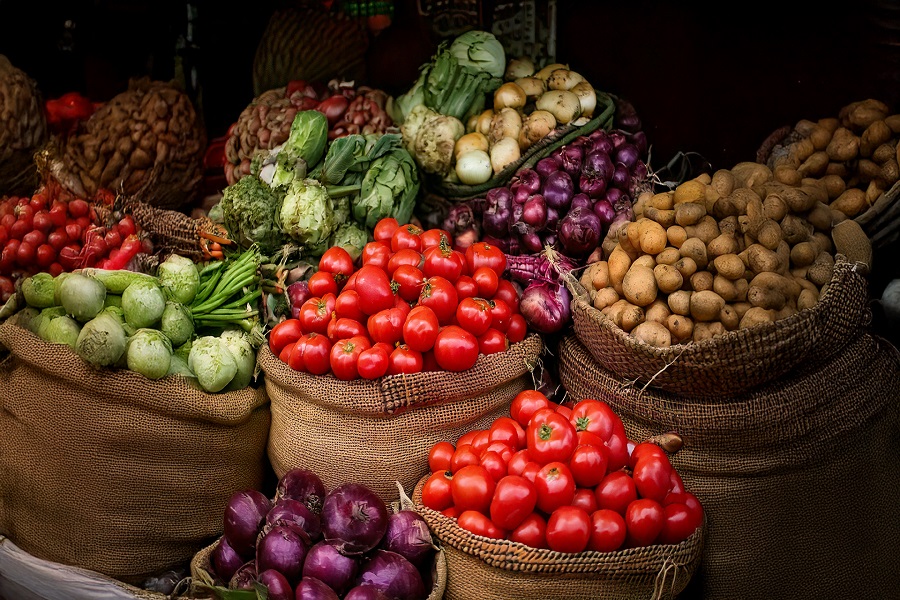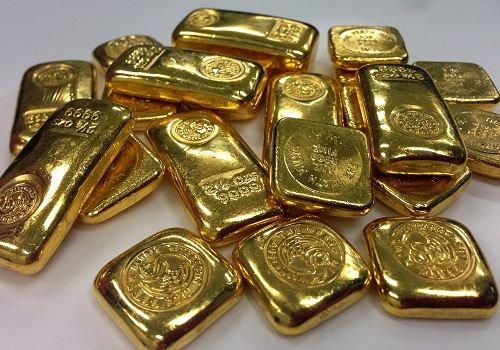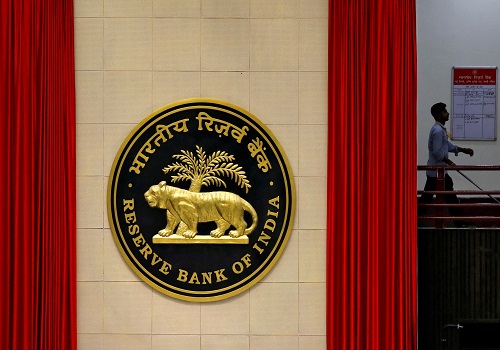Silver trading range for the day is 87585-90255 - Kedia Advisory

Gold
Gold prices settled down by -0.3% at 74,934 as the US dollar strengthened and expectations for a larger rate cut in November diminished. The Federal Reserve’s September meeting minutes revealed uncertainty among officials about the size of future rate cuts. While the Fed opted for a half-point reduction, Governor Bowman opposed the decision, favoring a smaller 25-basis-point cut, marking the first dissent on rates by a Fed governor since 2005. Dallas Fed President Lorie Logan supported the larger cut but emphasized that future reductions should be smaller, considering persistent inflation risks and economic uncertainties. Markets now expect an 88% chance of a 25-basis-point cut in November, reducing the likelihood of a 50-basis-point cut following last week’s strong jobs report. In India, record-high gold prices have tempered festive demand, despite hopes of a boost from a recent import duty cut. Gold imports surged 216% in August compared to the previous month, but jewellers remain cautious about building up stock. Indian dealers offered discounts of up to $21 an ounce, while discounts in top consumer China widened due to weak demand, with the Golden Week holiday keeping markets closed. Technically, gold is under long liquidation, with a drop in open interest by -1.87% to settle at 14,303 contracts, while prices fell by 227 rupees. Gold is currently supported at 74,745, and a break below this level could test 74,550. On the upside, resistance is seen at 75,235, and a move above could push prices to test 75,530.
Trading Ideas:
* Gold trading range for the day is 74550-75530.
* Gold retreated on an advancing dollar and diminished expectations for a larger rate cut in November.
* Federal Reserve officials were uncertain about the extent of interest rate cuts
* Fed's Logan calls for 'gradual' rate cuts, says 'should not rush'
Silver
Silver prices settled up by 0.16% at 88,872 due to short covering, after a recent dip driven by traders scaling back expectations for aggressive rate cuts by the Federal Reserve. New York Fed President John Williams emphasized the need for rate reductions "over time," while Fed Governor Adriana Kugler hinted at further easing if inflation continues to cool. Vice Chair Philip Jefferson described last month’s 50-basis-point rate cut as "timely," aligning with the Fed’s mandates of controlling inflation and maintaining maximum employment. Despite rate hikes, unemployment has remained under 4%, enabling the Fed to focus more on inflation control. In addition, India’s silver imports are expected to nearly double this year due to increased demand from the solar panel and electronics sectors, as well as investors anticipating stronger returns from silver compared to gold. India's silver imports surged to 4,554 metric tons in the first half of 2024, up from 560 tons a year ago, reflecting strong stockpiling by industrial buyers amid depleted inventories in 2023 and rising prices. These higher imports could support global silver prices, which are already nearing their highest levels in over a decade. Technically, the silver market is under short covering as open interest dropped by 2.06% to settle at 28,647 contracts, while prices rose by 143. Silver is currently supported at 88,225, with a potential test of 87,585 on the downside. Resistance is seen at 89,560, and a move above this level could lead to prices testing 90,255.
Trading Ideas:
* Silver trading range for the day is 87585-90255.
* Silver recovered losses on short covering as investors prepared for the September consumer price index report
* Prices also came under pressure after NDRC IN China provided few details on further stimulus measures.
* Fed’s Williams said that it will be appropriate again for the central bank to reduce rates 'over time.'
Crude oil
Crude oil prices dropped by -2% to settle at 6,119 as supply disruption concerns eased following reports that Israel is unlikely to target Iranian oil facilities, focusing instead on military installations. Additionally, concerns about Chinese economic growth and a potential demand slowdown also weighed on prices. China's National Development and Reform Commission pledged to implement measures to support the economy, but the lack of concrete details disappointed the market, particularly given China's ongoing housing crisis, weak consumption, and rising local government debt. Goldman Sachs reported a slight decrease in geopolitical risk premiums in the oil market, following a sharp rise last week. Despite this, Goldman Sachs still anticipates a potential $10-$20 per barrel increase for Brent in the event of disruptions to Iranian oil production. Meanwhile, U.S. crude oil inventories increased by 5.81 million barrels last week, the highest in over five months, exceeding expectations of a 2 million barrel increase. However, gasoline stocks fell sharply by 6.3 million barrels, more than the forecasted 1.1 million decline, while distillate inventories dropped by 3.1 million barrels. The U.S. Energy Information Administration (EIA) revised its global oil demand growth forecasts downward, citing weakening economic activity in China and North America. It now expects world oil demand to grow by 1.2 million barrels per day (bpd) in 2024, about 300,000 bpd below previous forecasts. Technically, crude oil is under long liquidation, with open interest down by -2.41% to settle at 11,949 contracts, while prices fell by 125 rupees. Crude oil has support at 6,002, with a potential test of 5,885 if breached. Resistance is seen at 6,246, and a break above could lead to prices testing 6,373.
Trading Ideas:
* Crudeoil trading range for the day is 5885-6373.
* Crude oil tumbled as supply disruptions concerns eased a bit on reports Israel is unlikely to attack Iranian oil facilities.
* Worries about Chinese growth outlook and concerns about demand slowdown hurt as well.
* Geopolitical risk premium in oil market slips slightly, Goldman Sachs says
Natural gas
Natural gas prices dropped by -3.93% to 222.7 due to expectations of reduced demand from power generators after Hurricane Milton knocked out power to potentially millions of homes and businesses in Florida. Lower demand projections coupled with production cuts contributed to the decline. Average gas output in the Lower 48 U.S. states fell to 101.0 bcfd in October, down from 101.8 bcfd in September, with record output seen in December 2023 at 105.5 bcfd. LSEG forecasted gas demand, including exports, to rise from 96.0 bcfd this week to 97.4 bcfd next week. Gas flows to U.S. LNG export plants also fell, averaging 12.4 bcfd in October, down from 12.7 bcfd in September, compared to a record high of 14.7 bcfd in December 2023. According to the U.S. Energy Information Administration (EIA), U.S. natural gas production will decline slightly to 103.5 bcfd in 2024 from 103.8 bcfd in 2023. However, domestic gas consumption is expected to rise to a record 90.1 bcfd in 2024 before easing in 2025. LNG exports are projected to reach 12.1 bcfd in 2024 and 13.8 bcfd in 2025. Additionally, U.S. utilities added 55 billion cubic feet of gas into storage for the week ending September 27, 2024, slightly below expectations of a 57 bcf increase, raising total stockpiles to 3,547 Bcf, which is 127 Bcf higher than last year and 190 Bcf above the five-year average. Technically, the natural gas market is under fresh selling pressure as open interest increased by 21.36%. Prices are down by 9.1, with support at 219.8, and below that, 216.9 levels may be tested. Resistance is now likely at 227.4, with potential to test 232.1 on the upside.
Trading Ideas:
* Naturalgas trading range for the day is 216.9-232.1.
* Natural gas eased on expectations power generators would burn less gas after Hurricane Milton.
* U.S. natural gas production will decline in 2024 while demand will rise to a record high
* Average gas output in the Lower 48 U.S. states fell to 101.0 bcfd so far in October, down from 101.8 bcfd in September.
Copper
Copper prices fell by -1.04% to settle at 826.25 as the market reacted to disappointment over the lack of additional stimulus measures from China's National Development and Reform Commission. Despite this, Chinese authorities did announce plans to accelerate special purpose bond issuances to support economic growth. Adding to the downward pressure on copper was the expectation of a less aggressive monetary easing from the Federal Reserve, following a stronger-than-expected U.S. jobs report for September. Copper stocks in Shanghai Futures Exchange warehouses have declined nearly 60% since June, now standing at 141,625 tons. However, concerns over tight supply were muted, as the LME cash copper contract showed a significant discount of $149.50 per ton against the three-month contract, signaling no near-term supply shortages. In the global refined copper market, the International Copper Study Group (ICSG) reported a surplus of 91,000 metric tons in July, following a surplus of 113,000 tons in June. For the first seven months of 2024, the market showed a surplus of 527,000 tons, up sharply from 79,000 tons in the same period in 2023. China’s unwrought copper imports fell to a 16-month low in August, down 12.3% year-on-year, reflecting weaker demand, although imports for the first eight months of the year were up 3% overall. Technically, the market is under long liquidation, with open interest falling by -4.98% to 8,158 contracts as prices dropped by 8.7 rupees. Copper is now supported at 818.5, with a potential test of 810.6 if breached. On the upside, resistance is seen at 838, and a move above this level could push prices toward 849.6.
Trading Ideas:
* Copper trading range for the day is 810.6-849.6.
* Copper tumbled as NDRC in China signaled no additional stimulus measures, disappointing markets.
* However, Chinese authorities announced plans to speed up special purpose bond issuances to support economic growth.
* Prices also came under pressure from growing expectations of a less aggressive easing campaign from the Fed.
Zinc
Zinc prices dropped by -1.46% to 276.45 as China's latest stimulus efforts failed to alleviate concerns about its economic recovery. The National Development and Reform Commission (NDRC) announced a 200 billion yuan ($28.3 billion) advance budget spending plan for investment projects, but the market remained skeptical. Despite this, BMI raised its zinc price forecast for 2024 to $2,700, citing tighter market fundamentals. Zinc also faced pressure from growing expectations of a less aggressive easing by the U.S. Federal Reserve after a stronger-than-expected September jobs report. Zinc inventories in warehouses monitored by the Shanghai Futures Exchange (SHFE) dropped to 79,980 metric tons. Meanwhile, the global refined zinc market is now expected to face a 164,000 metric ton deficit in 2024 due to reduced output in Europe and other regions, as per the International Lead and Zinc Study Group (ILZSG). This marks a shift from the previously forecasted surplus. European output is projected to decline by 11.4% this year, with reductions also seen in China, Canada, and Peru. China’s refined zinc production fell 0.68% month-on-month and 7.64% year-on-year in August, impacted by heavy rains, power rationing, and raw material procurement challenges. Some smelters resumed operations after maintenance, offsetting part of the decline. Technically, the zinc market is under long liquidation as open interest dropped by 19.58%, settling at 2,477 contracts. Zinc is now seeing support at 272.9, and below that could test 269.3. Resistance is likely at 281.4, with a move above potentially testing 286.3.
Trading Ideas:
* Zinc trading range for the day is 269.3-286.3.
* Zinc dropped as China's latest stimulus announcement failed to soothe doubts over economic recovery.
* BMI hiked its zinc price forecast for 2024 to $2,700, citing tighter market fundamentals.
* Zinc inventories in warehouses monitored by the Shanghai Futures Exchange (SHFE) dropped to 79,980 metric tons.
Aluminium
Aluminium prices fell by -0.89% to settle at 232.65 as producers sold forward to lock in high prices amidst uncertainty over China’s economic revival plans. The market reacted to disappointment after a lack of concrete stimulus measures from China’s top economic planning unit, leading to sharp corrections across commodities. Despite this, physical demand for aluminium remains stable, with Japan’s aluminium premium rising to $175 per metric ton, a 1.7% increase, indicating steady demand in Asia. Japan's premium acts as a key indicator of aluminium demand in the region. China’s aluminium output in August reached its highest level since 2002, with production totaling 3.73 million metric tons, 2.5% higher than the previous year. This surge in production was driven by high prices and the prospect of steady profits, particularly in regions like Yunnan, which benefitted from ample hydropower supply. For the first eight months of the year, China's aluminium production rose 5.1% year-on-year, reaching 28.91 million tons. Global primary aluminium output also grew by 2.4% year-on-year in July, with China contributing a significant portion of the total at 3.69 million tons. Technically, aluminium is under long liquidation as open interest fell by -13.5% to settle at 2,621 contracts, while prices dropped by 2.1 rupees. Aluminium has immediate support at 230.2, with a potential test of 227.6 if this level is breached. On the upside, resistance is seen at 235.4, and a break above could push prices towards 238. The market remains cautious as it awaits more clarity on China's economic stimulus measures.
Trading Ideas:
* Aluminium trading range for the day is 227.6-238.
* Aluminium fell with producers selling forward to lock in high prices and uncertainty over China's plan to revive its economy.
* Physical demand for aluminium remains stable.
* The premium for aluminium shipments to Japan was set at $175 a metric ton, up 1.7% from the prior quarter
Cotton candy
Cotton candy prices settled up by 0.11% at 56,810, supported by the USDA's revision of India's cotton production forecast for the 2024-25 season to 30.72 million bales, down from previous estimates, due to crop damage from excessive rains and pest issues. The reduction in India's ending stocks to 12.38 million bales added further support. However, upside movement remains limited due to moderate demand and weak export activity, especially to key markets like Bangladesh. India’s cotton output for the 2024-25 season is expected to remain at similar levels to last year, despite a 9% reduction in acreage, as higher yields from timely rains and lower pest incidence are anticipated to balance the lower planting area. Cotton exports for the 2023-24 season are estimated at 80% of the total, reaching 28 lakh bales, driven by strong demand from countries such as Bangladesh and Vietnam. On the global front, the U.S. cotton balance sheet for 2024/25 has been revised downward, with lower production, exports, and ending stocks. U.S. production is forecast at 14.5 million bales, down 600,000 bales from August due to reduced yields in the Southwest. Global cotton production and consumption have also been lowered, particularly in countries like the U.S., India, and Pakistan, offset by a larger crop in China. World ending stocks are reduced by 1.1 million bales to 76.5 million. Technically, the market is experiencing fresh buying, with open interest rising by 3.2% to 129 contracts, while prices increased by 60 rupees. Cotton candy is currently supported at 56,460, with a potential test of 56,110 if breached. Resistance is seen at 57,310, and a break above this level could push prices toward 57,810.
Trading Ideas:
* Cottoncandy trading range for the day is 56110-57810.
* Cotton gains as USDA has lowered India's cotton production forecast to 30.72 million bales.
* India’s cotton output for the 2024-25 cropping season is likely to be similar to last year’s levels.
* However upside seen limited amid moderate demand, with weak export activity.
* In the global 2024/25 cotton balance sheet, beginning stocks, production and consumption are increased.
Turmeric
Turmeric prices settled up by 0.46% at 14,004 due to reports of potential crop damage from heavy rains in Nanded and Hingoli, raising concerns that losses could be higher than previously anticipated. Despite this, upside momentum was limited due to lower demand and rising arrivals. Total arrivals were reported at 14,915 bags, lower than the previous session's 16,975 bags, with Sangli reporting only 890 bags compared to 11,000 previously. With five months remaining before harvesting, a combination of reduced supply and unfavorable weather conditions is expected to support prices in the coming weeks. However, increased turmeric sowing is capping further gains. In India, sowing in major areas like Maharashtra, Telangana, and Andhra Pradesh is estimated to be 30-35% higher compared to last year. Total turmeric acreage could rise from 3-3.25 lakh hectares last year to 3.75-4 lakh hectares in 2024. Additionally, global factors like accelerated harvesting in Indonesia due to dry weather and low export demand could also weigh on prices. Turmeric exports from India during April-July 2024 dropped by 13.97%, reaching 61,609.83 tonnes compared to 71,616.73 tonnes in the same period in 2023. Meanwhile, imports during the same period surged by 429.58%, reaching 12,828.08 tonnes. From a technical perspective, the turmeric market saw fresh buying as open interest increased by 5.81%, settling at 9,020 contracts, while prices rose by 64. Support is now seen at 13,826, with a possible test of 13,650 if the downside persists. Resistance is likely at 14,234, and a move above this level could push prices toward 14,466.
Trading Ideas:
* Turmeric trading range for the day is 13650-14466.
* Turmeric gains amid reports of crop damage due to heavy rains in Nanded and Hingoli areas
* However upside seen limited due to lower demand amid a rise in arrivals.
* Turmeric sowing on the Erode line is reported to be double as compared to last year
* In Nizamabad, a major spot market, the price ended at 14154 Rupees dropped by -0.99 percent.
Jeera
Jeera prices settled down by -0.15% at 26,145 amid robust domestic and export demand but were capped by expectations of higher production. Farmers are holding back their stocks, anticipating better prices, which is also providing support. However, the market remains cautious due to the substantial increase in cultivation areas in key producing regions like Gujarat and Rajasthan. Gujarat's sowing area has increased by 104%, while Rajasthan's has risen by 16%, leading to an expected 30% rise in overall jeera production this season, with output projected between 8.5-9 lakh tonnes. Globally, jeera production has surged, with China's output more than doubling to 55-60 thousand tons. Increased production in Syria, Turkey, and Afghanistan is also expected to put pressure on prices as new supplies enter the market. Additionally, reduced export trade in cumin has contributed to the recent price declines, indicating a shift in global cumin market dynamics. Despite this, India’s jeera exports during April-July 2024 rose by 58.31%, reaching 91,070.02 tonnes, compared to 57,526.22 tonnes in the same period of 2023. Technically, the market is under long liquidation, with open interest down by -0.73% to settle at 2,037 contracts while prices dropped by 40 rupees. Jeera has support at 26,010, with a potential test of 25,870 if this level is breached. On the upside, resistance is likely at 26,340, and a move above this level could push prices toward 26,530. The market is currently navigating strong demand against the backdrop of higher production expectations.
Trading Ideas:
* Jeera trading range for the day is 25870-26530.
* Jeera settled flat amid robust domestic and export demand besides tight global supplies.
* However upside seen limited as the expectation of higher production weighed on the prices. cent.
* Turkey anticipates producing 12-15 thousand tons, while Afghanistan's output could double.
* In Unjha, a major spot market, the price ended at 26485.5 Rupees dropped by -0.1 percent.
Views express by all participants are for information & academic purpose only. Kindly read disclaimer before referring below views






.jpg)



Tag News

Evening Roundup : A Daily Report on Bullion Energy & Base Metals for 12th September 2025 - G...












